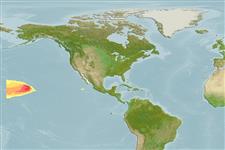Classification / Names
Nomi Comuni | Sinonimi | Catalog of Fishes(Genere, Specie) | ITIS | CoL | WoRMS | Cloffa
>
Stomiiformes (Lightfishes and dragonfishes) >
Stomiidae (Barbeled dragonfishes) > Melanostomiinae
Etymology: Eustomias: Greek, eu = good + Greek, stoma = mouth (Ref. 45335); elongatus: Named in reference to its elongate terminal bulb as well as fact that this species has the relatively longest barbel among known species of Dinematochirus (Ref. 45801).
Environment: milieu / climate zone / depth range / distribution range
Ecologia
marino batipelagico; distribuzione batimetrica 0 - 370 m (Ref. 45801). Deep-water
Eastern Central Pacific: near Hawaii and two stations to the west.
Size / Peso / Age
Maturity: Lm ? range ? - ? cm
Max length : 13.4 cm SL (female)
Short description
Chiavi di identificazione | Morfologia | Morfometria
BL greater than 20% SL; barbel with five similar branches apparently arising together from main stem (lateral pair actually arising from bases of medio-lateral pair); stem solidly pigmented, pigment extending onto dorsal side of terminal bulb; bulb elongate, only slightly thicker than stem, with an unpigmented tip usually directed dorsad; terminal filament absent or single and minute, arising from ventral side of bulb tip (Ref. 45801).
Epi- and mesopelagic (Ref. 58302).
Life cycle and mating behavior
Maturità | Riproduzione | Deposizione | Uova | Fecundity | Larve
Clarke, T.A., 2001. Pelagic fishes of the genus Eustomias, subgenus Dinematochirus (Stomiidae), in the Indo-Pacific with the description of twelve new speices. Copeia 2001(3):683-699. (Ref. 45801)
IUCN Red List Status (Ref. 130435: Version 2024-2)
Threat to humans
Harmless
Human uses
Pesca: di nessun interesse
Strumenti
Special reports
Download XML
Fonti Internet
Estimates based on models
Preferred temperature (Ref.
123201): 9.3 - 15.3, mean 15.1 °C (based on 3 cells).
Phylogenetic diversity index (Ref.
82804): PD
50 = 0.5000 [Uniqueness, from 0.5 = low to 2.0 = high].
Bayesian length-weight: a=0.00302 (0.00116 - 0.00786), b=3.12 (2.89 - 3.35), in cm total length, based on LWR estimates for this (Sub)family-body shape (Ref.
93245).
Trophic level (Ref.
69278): 4.2 ±0.8 se; based on size and trophs of closest relatives
Resilienza (Ref.
120179): Alto, tempo minimo di raddoppiamento della popolazione meno di 15 mesi (Preliminary K or Fecundity.).
Fishing Vulnerability (Ref.
59153): Low vulnerability (10 of 100).
